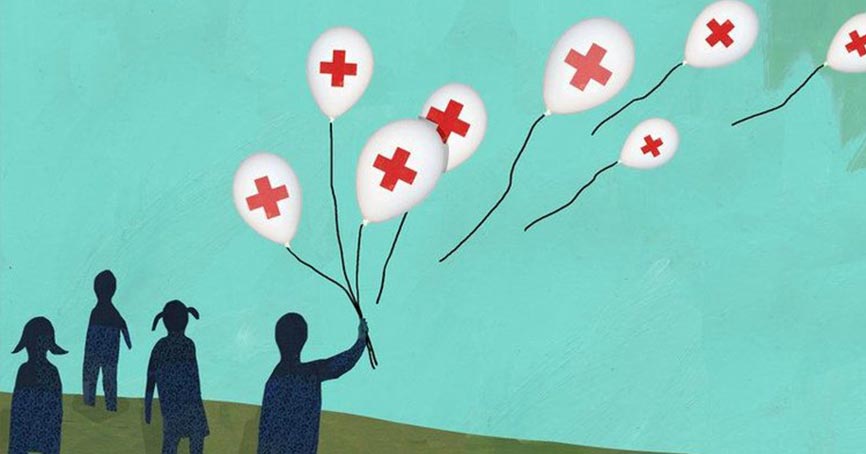The lungs are located in the chest and are known to take in oxygen when you inhale and release carbon dioxide when you exhale. Lung Cancer is the type of cancer that originates from the lungs. One of the leading causes of fatalities all over the world, lung cancer symptoms are hard to spot and the disease is time taking to diagnose.
Lung Cancer Symptoms
In the earlier stages, lung cancer does not cause any signs or symptoms. However, when the disease spreads and becomes advanced, the signs and symptoms begin to show. Some of the common symptoms of lung cancer are-
- Coughing up blood- Hemoptysis (smaller amounts are dangerous too)
- Shortness of Breath
- A persistent cough that refuses to go away
- Excessive Weight Loss
- Chest Pain
- Paralysis of vocal cords leading to Hoarseness
- A headache
- Pain in the bones
- Difficulty in breathing
- Shoulder Pain (if the tumor has traveled to the nerves)
Lung Cancer Causes
Majority of lung cancer cases are due to smoking - both in smokers and people exposed to the smoke. However, a person who has not been a regular smoker is also vulnerable to the disease. In such cases, the causes of cancer are usually not known.
Smoking
Tobacco smoking, the main contributor to the deadly disease, causes lung cancer by damaging the cells lining the lungs. When a person inhales smoke from a cigarette, the lung tissues change almost immediately.
Initially the body is able to repair the damage, however, with excessive smoking, repair becomes difficult. This leads to deterioration of the lung lining, leading which develops cancer.
Passive Smoking
Cancer can affect you also if you have friends or colleagues who smoke. Inhaling smoke from other regular smokers is another cause of lung cancer. A passive smoker is a person who is working or living with a smoker.
Radon Gas
Radon gas, generated by the breakdown of radioactive radium, is the decay product of uranium found in the Earth's crust. It is a colorless and odorless gas which is the second most common cause of cancer all over the world.
Asbestos
Asbestos is responsible for a variety of lung diseases including lung cancer too. Tobacco smoking and asbestos have an even greater effect on the formation of this deadly disease.
Air pollution
With the air quality becoming poorer with each passing day, the risk of lung cancer is ever increasing. Air pollutants, mainly chemicals released from fossil fuels increase the risk of lung cancer. Finer particulates that are released during traffic exhaust fumes and are associated with increased risks.
Women, on the other hand, have exposure to indoor air pollution that comes from burning of wood, charcoal, dung, etc.
Genetics
A large percentage of lung cancers are inherited from the family. For people who have relatives diagnosed with the deadly disease, the risk is even more. This works due to the combination of genes increasing the possibilities.
Other causes
Lung cancer may result due to plenty of other causes as well. In fact, factors like environmental exposures and occupations are are behind the deadly disease. Below are a few components that are carcinogenic in the lungs-
- Metals like aluminum production, chromium, beryllium compounds, etc.
- Crystalline silica dust and rubber production
- Products of combustion like coal, coke production, soot, diesel engine exhaust, etc.
- Toxic gases like methyl ether, MOPP, fumes from painting, etc.
- Ionizing Radiation (X-Radiation, Plutonium, Gamma Radiation)
- People with systemic sclerosis are prone to the risk of lung cancer too.
Lung Cancer Types
Lung Cancer is mainly of two types, small cell lung cancer, and non-small cell lung cancer. However, a few cancer tumors take the form of carcinoid tumor and other cancerous tumors are hard to find. Some of the rarest forms of cancer tumors are adenoid, cystic carcinoma, sarcomas, and lymphomas.
Non-Small Cell Lung Cancer
The most common type of lung cancer, it accounts for nearly 90% of the cancer cases. This type of cancer spreads to the organs and other tissues slowly as compared to the small cell lung cancer and it is less aggressive.
Small Cell Lung Cancer
The small cell lung cancer accounts for a small number of lung cancer cases and is also called oat cell lung cancer. This type of cancer spreads rapidly in the body which is why it is even more dangerous.
Lung Cancer Diagnosis
Lung cancer can be diagnosed by a series of tests and scans the doctor may advise.
- Healthy people must get an annual screening done including low-dose CT scans.
- If one is able to identify certain symptoms, the doctor would recommend performing a number of tests searching for cancerous cells. Some of the tests are- Imaging tests, Sputum cytology, etc.
- The doctor may perform a tissue sample biopsy.
- One cancer has been diagnosed, the doctor will perform tests to understand how far has the cancer spread. Some staging tests include CT, MRI, PET and bone scans.

 Jun 04, 2019
Jun 04, 2019
 May 30, 2018
May 30, 2018 May 10, 2018
May 10, 2018 May 17, 2018
May 17, 2018